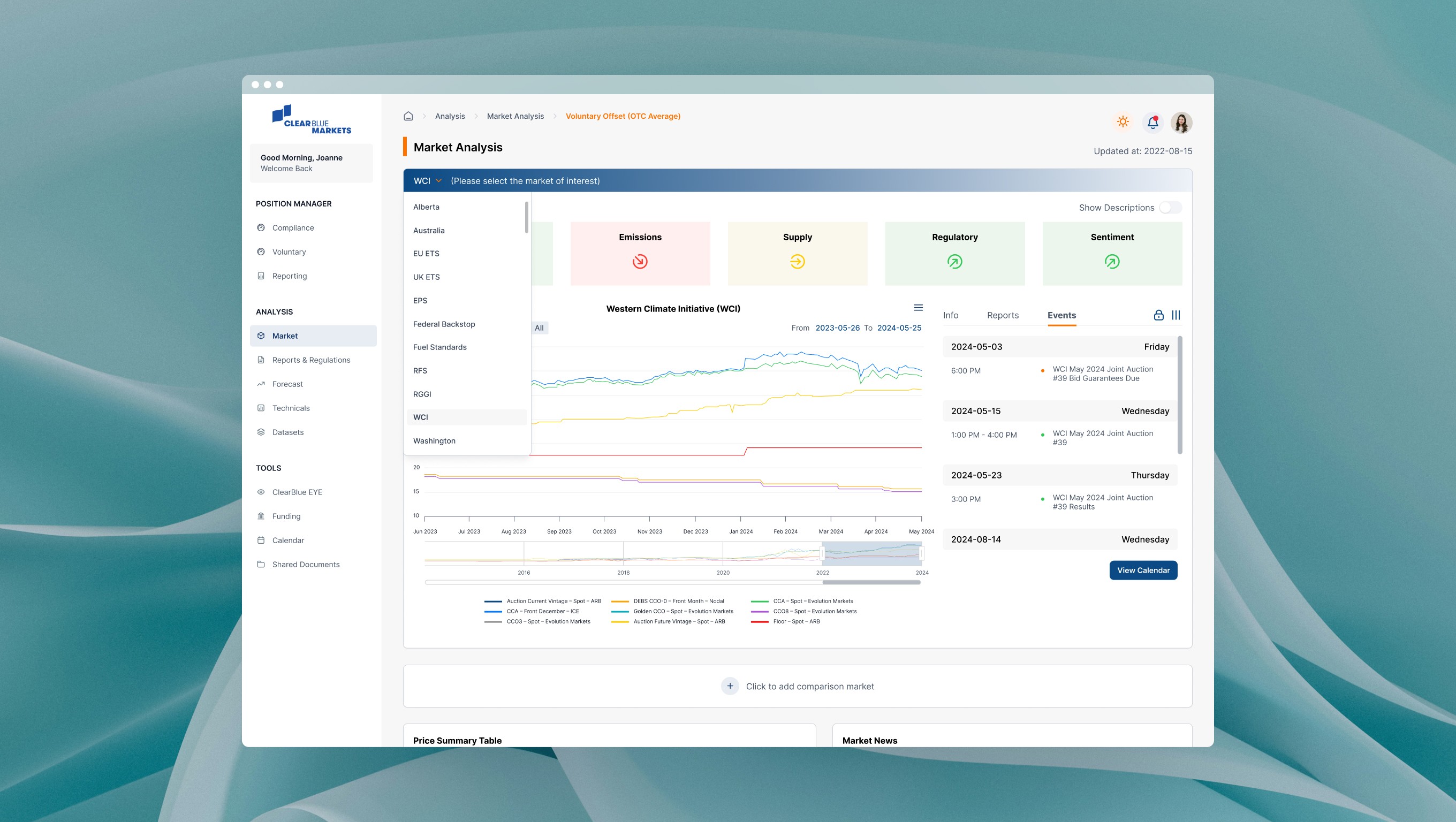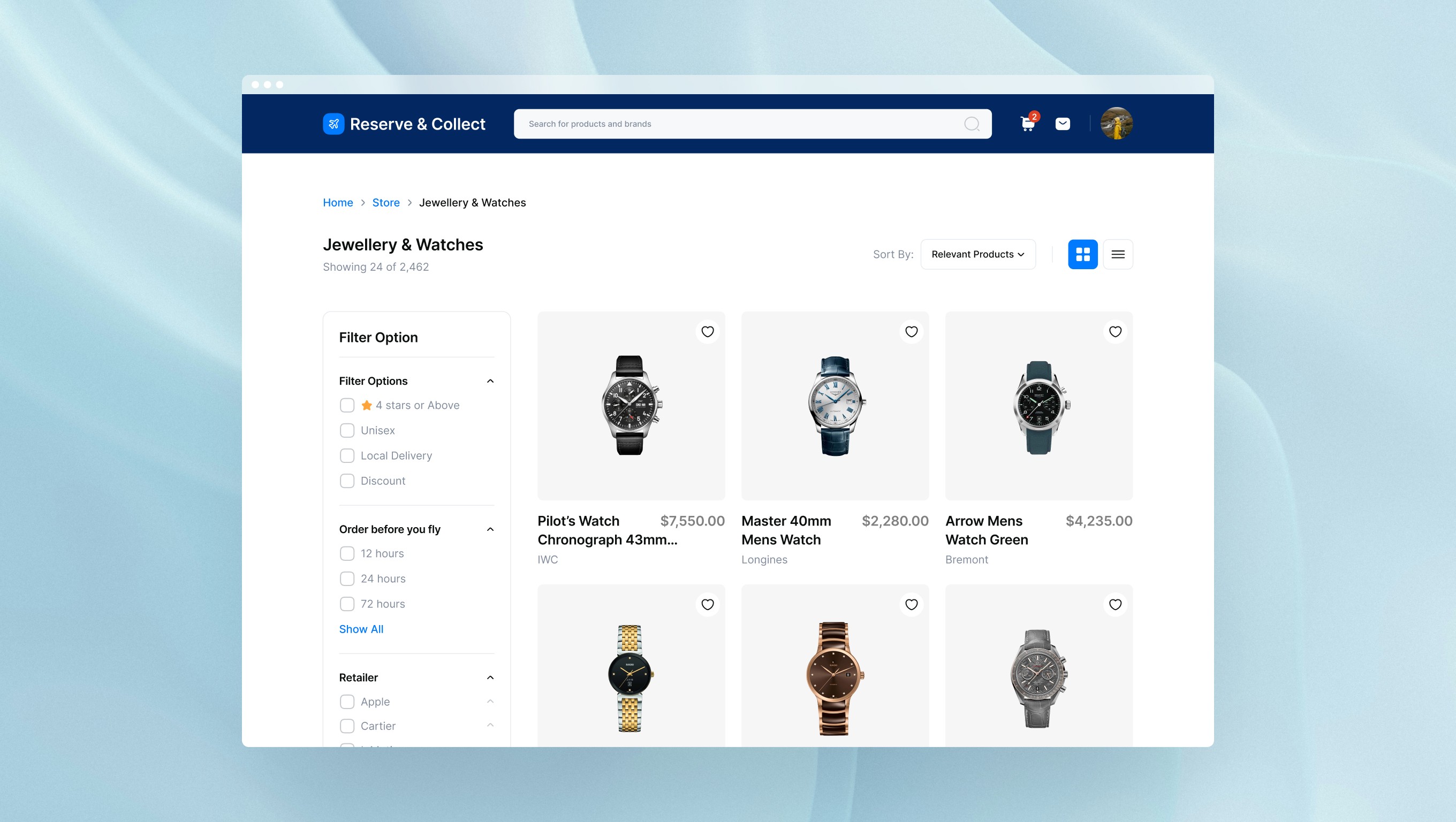Product Management, ClimateTech
ClearBlue Vantage
After finishing my time at Ivey, I decided to skip the grad / grad trip route for an opportunity to build in climate tech. Having already completed two internships in consulting, I knew I wanted to be somewhere flatter, nimbler, and willing to take bigger bets; somewhere you 'could just do things.'
I joined ClearBlue Markets as its first junior product hire, working alongside a Lead PM to shape the org's early product culture and accelerate the development and release of new solutions to market.
Role: Product Management Intern
Duration: May 2023 – August 2023 (4 months)
Team: Product Manager, Product Designer, 2x Engineers, 2x Carbon Advisors
Skills: Communication, Execution, Product Analytics, User Research
I. Overview
Context
ClearBlue Markets is a climate tech startup that helps organizations (industrial emitters, institutional investors, tech giants) achieve their decarbonization goals through participation in the Compliance and Voluntary Carbon Markets. Its flagship offering, Vantage, is a web platform that assists clients in improving their decision-making through three product verticals: Market Intelligence, Position Optimization, and Offset Price Discovery. Think of Vantage as the Bloomberg Terminal to the carbon markets.

The Challenge
ClearBlue originally started as a service-based firm with a client portal, a simple tool for running calculations and sharing reports. Like many advisory firms, the tech was built to support the service, not drive it. However, over time, clients began gravitating toward the platform’s self-serve features, relying less on human advisors for performing manual tasks.
It soon became clear to the co-founders that this platform was underdeveloped for what it could be: a way to deliver services more efficiently, and help clients move quicker toward their net zero goals. In response to this opportunity, ClearBlue raised a Series A to scale its engineering capabilities.
While the MVP was still being updated from time to time, it wasn’t addressing the core challenge: the lack of a dedicated function to align Leadership, Engineering, and Advisory teams under a shared vision. This gap was especially noticeable in an industry like carbon markets, where deep subject-matter expertise is hard to find on the tech side, and few engineers come in familiar with the space.

On top of that, the product did not have a clear go-to-market strategy, and both internal and external users were growing frustrated with the dated interface and limited flexibility of key features. With that context in mind, I approached my internship with the following question:
"How might we build and launch the next iteration of Vantage to accelerate ClearBlue's transition into a technology-driven company supported effectively by its services?"
II. My Role
My Approach
Over the summer, I managed two key initiatives: coordinating Vantage’s v2 launch and leading the discovery and solutioning for Position Optimization, which would be integrated later within the platform. As the two projects ran under separate timelines, I approached my work with the following mindset:
Managing Different Altitudes: One skill I quickly picked up on was the ability to switch between detailed, in-the-weeds execution and high-level strategy. For instance, while launch coordination involved traditional project management, like facilitating meetings and removing blockers, Position Optimization required a more nuanced approach to uncovering customer pain points, validating ideas, and prioritizing backlog items. I had to adapt my PM style relative to the context of my work.
Defining Your Assumptions: Since the carbon markets were a more complex subject area than my previous experiences, I frequently ran product reviews with our Advisory team to validate important decisions. I would kick off each session by voicing my understanding of the topic to level-set on the principles to my thinking. This approach created a feedback loop where I gradually became more knowledgeable about the industry, and, in turn, gained more trust from the Advisors.

My Process
A. Upskilling and Exploration
In my first few weeks at ClearBlue, I focused on getting up to speed on the carbon markets, especially the Ontario EPS and Quebec WCI, which were central to our product. To achieve this, I dove into the regulations and set up 1-on-1s with our Advisors to answer as many burning questions as possible. Along the way, I built a shared knowledge base to help the broader sales, design, and development teams learn with me. Fun fact: this resource ended up being super helpful for onboarding new hires who joined later in the summer.
During discovery, I joined user research sessions to get a clearer picture of where customers were struggling with the current platform. I captured detailed notes, organized my findings in Dovetail, and worked closely with my PM to separate signal from noise.
Off the back of these activities, I put together two key artifacts: a PRD that mapped out the problem space, opportunities, and technical requirements for Position Optimization, and a value proposition doc outlining customer expectations for the next release of Vantage. I presented both to the relevant VPs to build early momentum and get buy-in on the upcoming roadmap.
B. Feature Design
Once the value proposition and business goals for Position Optimization were in place, I partnered with my Designer to begin exploring potential product directions. To start, I pulled together user feedback from multiple sources to write requirements and build low-fidelity wireframes. While some specs were improvements on what we had in v1, others were entirely new, like metrics for tracking risk exposure and interactive dashboard widgets. I also led recurring product reviews and design crits with our cross-functional partners (e.g., Market Intelligence, Advisory, Offsets), which sped up the transition from design to development.

C. Launch Coordination
With most of the specs handed off to design, I shifted gears to help get the broader Vantage platform ready for its V2 launch. One key update was integrating a headless CMS, allowing Advisory staff, not just engineers, to update parts of the portal independently. To support this rollout, I created internal how-to guides and led training sessions to get our non-technical teams up to speed. On the engineering side, I helped define access permissions, map out dynamic content areas, and assign ownership for each component, ensuring accountability and making it easier to manage updates over time.

D. Testing & Analytics
As we got closer to deployment, I led user acceptance testing across 50+ flows and wrote in-product copy for Vantage’s Market Analysis Pages. I also filed bug reports, triaged support tickets, and worked with a Backend Developer to troubleshoot automation issues.
As a separate initiative, I implemented Pendo to bring product analytics into Vantage for the first time. To support the V2 redesign, I set up an onboarding flow that enabled our sales team to monitor early user activations and built custom paths to flag drop-off points. I also created funnels to track engagement with certain features and integrated an NPS widget to collect direct user feedback. Together, these efforts laid the foundation for making more informed, data-driven product improvements moving forward.
My Impact
Looking back on my internship, I would describe my impact across three areas:
Product Culture: When I caught up with a colleague a few months after leaving my internship, I was surprised—and proud—to hear that many of the practices I introduced were still in use. One example was a tagging system I built in Dovetail, which organized user insights by emotions, needs, and suggestions. That system is still in place today, a small but meaningful sign of the cultural shift I’d hoped to bring to ClearBlue.
Product Enablement: I managed two key integrations in Vantage: one for self-serve content updates, and another for product analytics, which gave our Advisory, Engineering, and Data teams more autonomy and control over their workflows in the portal.
Product Execution: My work on Vantage and Position Optimization actively drove both initiatives forward, resulting in successful go-live decisions. These releases opened up new upselling opportunities to 200+ clients for our team (i.e., Deloitte, Bain Capital, Suncor).

III. Reflections & Takeaways
Key Learnings
Finding My Footing: When I first joined ClearBlue, I remember my hands were clammy from just talking to the VPs and Advisors at lunch. Most of the team had decades of experience, and I felt intimidated even being at the same table. Looking back, one of the biggest lessons I’ve learned is that experts don’t expect you to have all the answers. What they do expect is that you show up engaged and ready to grow. It’s the same advice I give every new hire or mentee today: show up curious.
Product in Theory vs. In Practice: One of the biggest culture shocks I experienced, after months of reading up on PM theory at school, was how rarely frameworks capture what real-life PM-ing is actually like. The day-to-day isn’t a neat, linear process. It’s messy. It’s about juggling layers of product debt, tough trade-offs, and decisions with limited information. What matters most is staying grounded in your customer and adapting your approach to the needs and rhythms of your team.
Being as Direct as Possible: Clarity takes you far in product because it forces you to be opinionated. That's why bullet points almost always win against long, detailed docs. Ami Vora said it best on Lenny's Podcast: "Write whatever you need to write and then cut out almost all of it." The goal is to bring enough context to make a clear, confident recommendation, and nothing more.

Conclusion
In my four months at ClearBlue, I had the opportunity to work alongside an incredibly smart, experienced team that trusted me, valued my input, and offered guidance, even with years more experience in the field. The internship pushed me to learn quickly and to visualize complex, ambiguous concepts to clarify my thinking, two of the most valuable strengths I carry today. Curious what that looks like in practice? Check out the eCommerce strategy project I worked on shortly after.
Discover more


